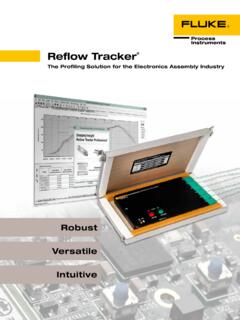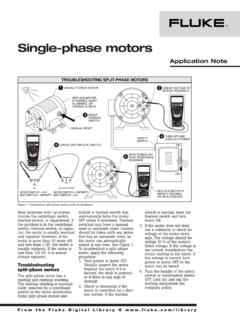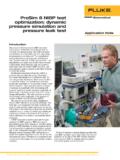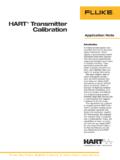Transcription of Insulation resistance testing - Fluke Corporation
1 Insulation resistancetestingIntroductionInsulation resistance testers canbe used to determine the integ-rity of windings or cables inmotors, transformers, switch-gear, and electrical test method is determinedby the type of equipment beingtested and the reason for test-ing. For instance, when testingelectrical cabling or switchgear(low-capacitance equipment)the time-dependent capacitiveleakage and absorption leakagecurrents become insignificantand decrease to zero almostinstantly. A steady conductiveleakage current flow is reachedalmost instantly (a minute orless) providing perfect condi-tions for the spot-reading/short-time resistance test. (For moredetailed information on leakagecurrents and resistance tests seethe following sections: What IsInsulation resistance & Leak-age Currents and PredictiveMaintenance Tests).
2 On the other hand, when theequipment to be tested is a longrun of cable, large motor, orgenerator (high-capacitanceequipment) the time-dependentcurrents will last for currents will cause themeter readings to change con-stantly, making it impossible toobtain an accurate steady read-ing. This condition can beovercome by using a test thatestablishes a trend betweenreadings, such as the step volt-age or dielectric-absorption tests do not depend on asingle reading but on a collec-tion of relative readings. Itwould be a waste of time toperform these tests on low-capacitance equipment sincethe time-dependent currentsdiminish quickly, resulting in allthe measurements being testingThe most important reason fortesting Insulation is to insurepublic and personal safety.
3 Byperforming a high dc voltagetest between de-energized cur-rent-carrying (hot), grounded,and grounding conductors, youcan eliminate the possibility ofhaving a life-threatening shortcircuit or short to ground. Thistest is usually performed afterthe initial installation of theequipment. This process willprotect the system againstmiswired and defective equip-ment, and it will insure a highquality installation, customersatisfaction, and protect againstfire or testingThe second most importantreason for Insulation testing isto protect and prolong the lifeof electrical systems and the years, electrical sys-tems are exposed to environ-mental factors such as dirt,grease, temperature, stress, andvibration. These conditions canlead to Insulation failure, result-ing in loss of production or evenfires.
4 Periodic maintenance testscan provide valuable informa-tion about the state of deteriora-tion and will help in predictingpossible failure of the problems will resultnot only in a trouble-free sys-tem, but will also extend theoperating life for a variety Note2 Fluke Corporation Insulation resistance testingWork safelySafety is everyone s responsi - bility , but ultimately it is in yourhands. No tool by itself canguarantee your safety. It is thecombination of the instrumentand safe work practices thatgives you maximum are a few safety tips youshould follow: Work on de-energized circuitswhenever proper lock-out/tag-outprocedures. If these proce-dures are not in place or notenforced, assume the circuitis live. On live circuits, use protectivegear: Use insulated tools Wear flame resistantclothing, safety glasses,and Insulation gloves Remove watches or otherjewelry Stand on an insulationmat When making voltage mea-surements on live circuits: Hook on the ground clipfirst, then make contactwith the hot lead.
5 Removethe hot lead first and theground lead last. Hang or rest the meter ifpossible. Try to avoid hold-ing it in your hands tominimize personalexposure to the effects oftransients. Use the three-point testmethod, especially whenchecking to see if a circuitis dead. First, test a knownlive circuit. Second, testthe target circuit. Third,test a live circuit verifies that yourmeter worked properlybefore and after the mea-surement. Use the old electricians trick of keeping one handin your pocket. This less-ens the chance of a closedcircuit across your chestand through your heart. When performing insulationand resistance tests: Never connect the insula-tion tester to energizedconductors or energizedequipment and alwaysfollow the manufacturer measuringIn order to obtain meaningfulinsulation resistance measure-ments, the electrician shouldcarefully examine the systemunder test.
6 The best results areachieved system or equipment istaken out of service anddisconnected from all othercircuits, switches, capacitors,brushes, lightning arrestors,and circuit breakers. Makesure that the measurementsare not affected by leakagecurrent through switchesand overcurrent The temperature of the con-ductor is above the dewpoint of the ambient this is not the case, amoisture coating will form on Shut down the equipmentto be tested by openingfuses, switches, and circuitbreakers. Disconnect the branchcircuit conductors,grounded conductors,grounding conductors, andall other equipment fromthe unit under test. Discharge conductorcapacitance, both beforeand after the test. Someinstruments may haveautomatic dischargefunctions.
7 Check for any leakagecurrent through fuses,switches, and breakers onde-energized current can causeinconsistent and incorrectreadings. Don t use an insulationtester in a dangerous orexplosive atmospheresince the instrument cangenerate arcing in dam-aged Insulation . Use insulated rubbergloves when connectingthe test Insulation surface, and, insome cases will be absorbedby the The surface of the conductoris free of carbon and otherforeign matter that can be-come conductive in Applied voltage is not toohigh. When testing low-voltage systems; too muchvoltage can overstress ordamage The system under test hasbeen completely dischargedto the ground. The groundingdischarge time should beabout five times the testingcharge The effect of temperature isconsidered.
8 Since insulationresistance is inversely propor-tional to Insulation tempera-ture ( resistance goes down astemperature goes up), therecorded readings are alteredby changes in the temperatureof the insulating material. It isrecommended that tests beperformed at a standard con-ductor temperature of 20 C(68 F). As a rule of thumb,when comparing readings to20 C base temperature,double the resistance for ev-ery 10 C (18 F) above 20 C orhalve the resistance for every10 C below 20 C in tempera-ture. For example, a one-me-gohm resistance at 40 C(10 4 F) will translate to four-megohm resistance at 20 C(68 ). To measure the conduc-tor temperature, use a non-contact infrared thermometersuch as the Fluke Fluke Corporation Insulation resistance testingWhat are insulationresistance andleakage currents?
9 During the testing procedure,the high dc voltage generatedby pressing the test button willcause a small (micro-amps)current flow through the con-ductor and the Insulation . Theamount of current depends onthe amount of voltage applied,the system s capacitance, thetotal resistance , and the tem-perature of the material. For afixed voltage, the higher thecurrent, the lower the resistance (E=IR, R=E/I). The total resis-tance is the sum of the internalresistance of the conductor(small value) plus the insulationresistance in M 1. Current componentsTotal Current(IA + IC + IL)Time(in seconds)0 Current(in A)InsulationResistance(in Megohms)ILICIAF igure 2. Conductive leakage current (IL)ILConductorsDielectricInsulationFigu re 3. Capacitive charging leakage current (IC)ICConductorsDielectricInsulationThe value of Insulation resis-tance read on the meter will bea function of following threeindependent leakagecurrent (IL)Conductive current is a small(micro-amp) amount of currentthat normally flows throughinsulation, between conductorsor from a conductor to current increases as insula-tion deteriorates and becomespredominant after the absorp-tion current (see Figure 1) van-ishes.
10 Because it is fairly steadyand time independent, this isthe most important current formeasuring Insulation charging leakagecurrent (IC)When two or more conductorsare run together in a raceway,they act as a capacitor. Due tothis capacitive effect, a leakagecurrent flows through conductorinsulation. This current lastsonly for a few seconds as the dcvoltage is applied and drops outafter the Insulation has beencharged to its full test low-capacitance equipment,the capacitive current is higherthan conductive leakage current,but usually disappears by thetime we start recording the of this, it is importantto let the reading settle out before recording it. On the otherhand, when testing high capaci-tance equipment the capacitivecharging leakage current canlast for a very long time beforesettling absorptionleakage current (IA)Absorption current is caused bythe polarization of moleculeswithin dielectric material.














